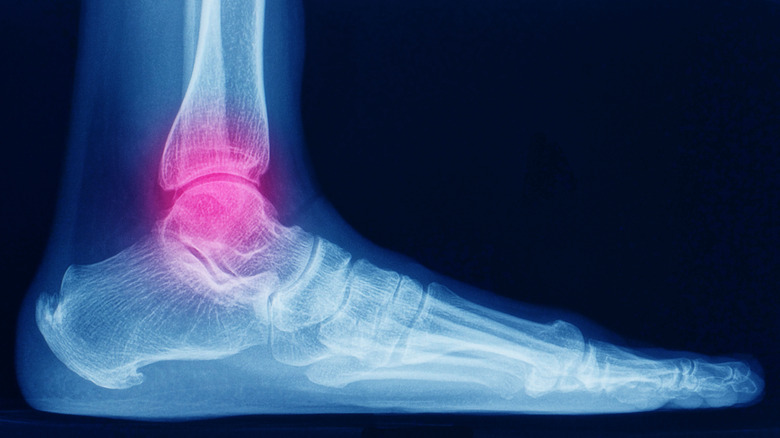What Happens If A Sprained Ankle Goes Untreated?
A sudden fall, stepping off a curb in high heels, or the playing of intensive sports such as soccer or basketball can all leave us susceptible to a sprained ankle (via Mayo Clinic). Rolling or twisting your foot in an unnatural way can cause damage, such as excessive tearing or stretching, to the ligaments in your ankle. When this occurs, it's considered a sprained ankle injury. A sprained ankle can vary in severity, but common symptoms include swelling, bruising, instability, restricted movement, and tenderness to the touch.
While accidents do happen, experts at the Mayo Clinic explain that certain risk factors can increase one's chances for a sprained ankle, such as walking on uneven surfaces, wearing ill-fitted shoes, and participating in sports activities, as well as having incurred any previous ankle injuries.
When compared to a severely broken bone, a mild ankle sprain may not look like much. It's easy to think that a little rest and the occasional application of an ice pack will have you back on the field in no time. But letting a sprained ankle go untreated may only further worsen the problem.
An untreated sprained ankle can lead to additional ankle problems
According to Orthopedics New England, ankle sprains account for 40% of all ankle-related injuries, and every seven in 1,000 people in the U.S. can expect to experience a sprained ankle. An ankle sprain can occur one of two ways. An ankle that has rolled inward is considered an inversion sprain, while an ankle that has rolled outwards is known as an eversion sprain. While the damage most often occurs within the ligaments along the outside of the ankle, pain on the inside of the ankle can be more serious and affect arch support.
A sprained ankle that's been left untreated can worsen and leave you susceptible to future health problems. According to experts at Arlington/Mansfield Foot & Ankle Centers, an untreated sprain can lead to continual instability in the ankle joint. Such weakness can increase your chances for additional future ankle injuries and can increase the likelihood of developing certain conditions, such as arthritis and chronic inflammation in the ankle.
For this reason, it's always important to consult with a doctor in the event of an ankle injury, and taking preventative measures can help decrease your chances of spraining your ankle. Experts at the Mayo Clinic suggest exercising caution when running or walking on uneven ground, warming up before physical activity, and wearing properly fitted shoes while limiting the use of high heels, as well as maintaining muscle strength and function through proper balancing exercises.


